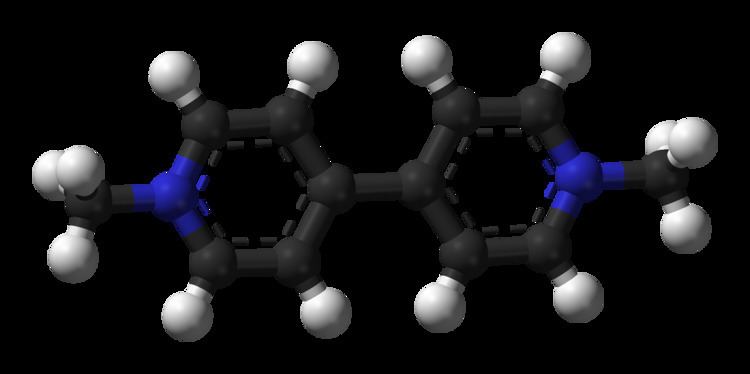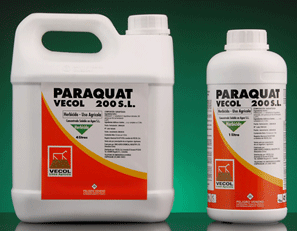Appearance Yellow solid Formula C12H14Cl2N2 Boiling point 300 °C Soluble in Water | Molar mass 257.16 g/mol Melting point 175 °C Density 1.25 g/cm³ | |
 | ||
IUPAC ID 1,1'-Dimethyl-4,4'-bipyridinium dichloride | ||
Paraquat s how to pronounce it
Paraquat (trivial name; /ˈpærəkwɑːt/) or N,N′-dimethyl-4,4′-bipyridinium dichloride (systematic name) is the organic compound with the chemical formula [(C6H7N)2]Cl2. It is classified as a viologen, a family of redox-active heterocycles of similar structure. Paraquat was manufactured by Chevron. This salt is one of the most widely used herbicides. It is quick-acting and non-selective, killing green plant tissue on contact. It is also toxic to human beings and animals. It is linked to development of Parkinson's disease. The name is derived from the para positions of the quaternary nitrogens. Quantities are sometimes expressed by cation mass alone (paraquat cation, paraquat ion); other salts (with other anions besides chloride) exist. In fact, its redox activity, which produces superoxide anions, is why it is toxic.
Contents
- Paraquat s how to pronounce it
- Paraquat
- Production
- Herbicide use
- Reactivity and mode of action
- Weed resistance management
- Toxicity
- Paraquat pot
- Use in suicide and murder
- Parkinsons disease
- References

Paraquat
Production

Pyridine is coupled by treatment with sodium in ammonia followed by oxidation. The resulting 4,4'-bipyridine is then methylated with chloromethane to give the title compound:
Herbicide use
Although first synthesized in 1882, paraquat's herbicidal properties were not recognized until 1955. Paraquat was first manufactured and sold by ICI in early 1962, and is today among the most commonly used herbicides.

The European Union approved the use of paraquat in 2004 but Sweden, supported by Denmark, Austria, and Finland, appealed this decision. In 2007, the court annulled the directive authorizing paraquat as an active plant protection substance stating that the 2004 decision was wrong in finding that there were no indications of neurotoxicity associated with paraquat and that the studies about the link between paraquat and Parkinson's disease should have been considered.
Paraquat is classified as non-selective contact herbicide. The key characteristics that distinguish it from other agents used in plant protection products are:
These properties led to paraquat being used in the development of no-till farming. Current research into no-till farming using mulching techniques as a substitute for herbicide application are producing good results
In the United States, paraquat is available primarily as a solution in various strengths. It is classified as "restricted use," which means that it can be used by licensed applicators only. In the European Union, paraquat has been forbidden since 2007. A small group of countries, including India and Guatemala and supported by manufacturers, has blocked the listing of paraquat as a hazardous chemical for the purposes of the Rotterdam Convention.
Reactivity and mode of action
Paraquat is an oxidant that interferes with electron transfer, a process that is common to all life. Addition of one electron gives the radical cation:
[MV]2+ + e−The radical cation is also susceptible to further reduction to the neutral [MV]0:
[MV]+ + e−As an herbicide, paraquat acts by inhibiting photosynthesis. In light-exposed plants, it accepts electrons from photosystem I (more specifically Fd, which is presented with electrons from PS I) and transfers them to molecular oxygen. In this manner, destructive reactive oxygen species are produced. In forming these reactive oxygen species, the oxidized form of paraquat is regenerated, and is again available to shunt electrons from photosystem I to restart the cycle.
Paraquat is often used in science to catalyze the formation of reactive oxygen species (ROS), more specifically, the superoxide free radical. Paraquat will undergo redox cycling in vivo, being reduced by an electron donor such as NADPH, before being oxidized by an electron receptor such as dioxygen to produce superoxide, a major ROS.
Weed resistance management
Problems with herbicide resistant weeds may be addressed by applying herbicides with different modes of action, along with cultural methods such as crop rotation, in integrated weed management (IWM) systems. Paraquat, with its distinctive mode of action, is one of few chemical options that can be used to prevent and mitigate problems with weeds that have become resistant to the very widely used non-selective herbicide glyphosate.
One example is the "Double Knock" system used in Australia. Before planting a crop, weeds are sprayed with glyphosate first, then followed seven to ten days later by a paraquat herbicide. Although twice as expensive as using a single glyphosate spray, the "Double Knock" system is an important resistance management strategy widely relied upon by farmers. Nevertheless, herbicide resistance has been seen for both herbicides in Western Australia.
A computer simulation showed that with alternating annual use between glyphosate and paraquat, only one field in five would be expected to have glyphosate-resistant annual ryegrass (Lolium rigidum) after 30 years, compared to nearly 90% of fields sprayed only with glyphosate. A "Double Knock" regime with paraquat cleaning-up after glyphosate was predicted to keep all fields free of glyphosate resistant ryegrass for at least 30 years.
Toxicity
Pure paraquat, when ingested, is highly toxic to mammals, including humans, potentially leading to acute respiratory distress syndrome (ARDS). Although there are no specific antidotes, fuller's earth or activated charcoal is an effective treatment if taken in time. There have been some successful cases of using cyclophosphamide (Endoxan) to treat paraquat poisoning. Death may occur up to 30 days after ingestion. Diluted paraquat used for spraying is less toxic; thus, the greatest risk of accidental poisoning is during mixing and loading paraquat for use.
In acute toxicity studies using laboratory animals, paraquat has been shown to be highly toxic by the inhalation route and has been placed in Toxicity Category I (the highest of four levels) for acute inhalation effects. However, the EPA has determined that particles used in agricultural practices (400 to 800 μm) are well beyond the respirable range and therefore inhalation toxicity is not a toxicological endpoint of concern. Paraquat is toxic (Category II) by the oral route and moderately toxic (Category III) by the dermal route. Paraquat will cause moderate to severe eye irritation and minimal dermal irritation, and has been placed in Toxicity Categories II and IV (slightly toxic) respectively for these effects.
The alveolar epithelial cells of the lung selectively concentrates paraquat. Even a single swig, immediately spat out, can cause death from fibrous tissue developing in the lungs, leading to asphyxiation.
One of the characters in the infamous British public information film Apaches (1977) dies hours after accidentally swallowing a small amount; the paraquat in the film is contained in a receptacle similar to a whisky bottle.
According to the Centers for Disease Control, ingesting paraquat causes symptoms such as liver, lung, heart, and kidney failure within several days to several weeks that can lead to death up to 30 days after ingestion. Those who suffer large exposures are unlikely to survive. Chronic exposure can lead to lung damage, kidney failure, heart failure, and oesophageal strictures. Accidental deaths and suicides from paraquat ingestion are relatively common. For example, there have been 18 deaths in Australia from paraquat poisoning since 2000. Long-term exposures to paraquat would most likely cause lung and eye damage, but reproductive/fertility damage was not found by the United States Environmental Protection Agency (EPA) in their review.
"Paraquat pot"
During the late 1970s, a controversial program sponsored by the US government sprayed paraquat on cannabis fields in Mexico. Mexico began efforts to eradicate marijuana and poppy fields in 1975. The United States government helped by sending helicopters and tech assistance. Helicopters were used to spray herbicides paraquat and 2,4-D on the fields and contaminated pot began to show up in US market. Since much of this cannabis was subsequently smoked by Americans, the US government's "Paraquat Pot" program stirred much debate. Perhaps in an attempt to deter people from using cannabis, representatives of the program warned that spraying rendered the crop unsafe to smoke. However, a 1995 study found that "no lung or other injury in cannabis users has ever been attributed to paraquat contamination". Also a United States Environmental Protection Agency manual states: "... toxic effects caused by this mechanism have been either very rare or nonexistent. Most paraquat that contaminates cannabis is pyrolyzed during smoking to dipyridyl, which is a product of combustion of the leaf material itself (including cannabis) and presents little toxic hazard."
In a study by Imperial Chemical Industries, rats who inhaled paraquat showed development of squamous metaplasia in their respiratory tracts after a couple of weeks. This study was included in a report given to the State Department by the Mitre Corporation. The U.S. Public Health Service stated that "this study should not be used to calculate the safe inhalation dose of paraquat in humans."
Use in suicide and murder
A large majority (93 percent) of fatalities from paraquat poisoning are suicides, which occur mostly in developing countries. For instance, in Samoa from 1979–2001, 70 percent of suicides were by paraquat poisoning. Trinidad and Tobago is particularly well known for its incidence of suicides involving the use of Gramoxone (commercial name of paraquat). In southern Trinidad, particularly in Penal, Debe from 1996–1997, 76 percent of suicides were by paraquat, 96 percent of which involved the over-consumption of alcohol such as rum. Fashion celebrity Isabella Blow committed suicide using paraquat in 2007. Paraquat is widely used as a suicide agent in third-world countries because it is widely available at low cost. Further, the toxic dose is low (10 mL or 2 teaspoons is enough to kill). Campaigns exist to control or even ban paraquat, and there are moves to restrict its availability by requiring user education and the locking up of paraquat stores.
The indiscriminate paraquat murders, which occurred in Japan in 1985, were carried out using paraquat as a poison.
Paraquat, as the weedkiller Gramoxone, was used in the UK in 1981 by Susan Barber to poison the gravy of her husband Michael's pie. She was convicted of murder in November 1982, maintaining throughout that she had not intended to kill him.
Parkinson's disease
In 2011, a US National Institutes of Health study showed a link between paraquat use and Parkinson's disease in farm workers. A co-author of the paper said that paraquat increases production of certain oxygen derivatives that may harm cellular structures, and that people who used paraquat, or other pesticides with a similar mechanism of action, were more likely to develop Parkinson's. Paraquat-induced toxicity in rats has also been linked to Parkinson's-like neurological degenerative mechanisms. A study by the Buck Institute for Research on Aging showed a connection between exposure to paraquat and iron in infancy and mid-life Parkinson's in laboratory mice. A 2013 meta-analysis published in Neurology found that 'exposure to paraquat ... was associated with about a 2-fold increase in risk' of Parkinson's disease.
Paraquat is structurally similar to MPP+, a known fast-acting inducer of Parkinson's disease in primate brains. The chloride of MPP+ was sold under the trade name Cyperquat.
Paraquat also induces oxidative stress in invertebrates such as Drosophila melanogaster. Paraquat-fed flies suffer early-onset mortality and significant increases in superoxide dismutase activity.
